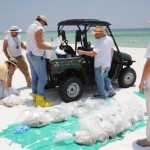The State Emergency Response Team and the Florida Department of Environmental Protection (DEP) continued to actively coordinate and respond to the oil gushing from the Deepwater Horizon leaking well, as more dime to five inch-sized tar balls and tar patties are found in northwest Florida.
The majority of impacts to the state’s shoreline, DEP said, are likely to be highly weathered, in the form of tar balls, oil sheen, tar mats or mousse–a pudding-like oil/water mixture that could be brown, rust or orange in color.
According to NOAA, no significant amounts of oil are moving are moving toward the Loop Current. The Loop Current Ring, a circular current, has reattached to the main Loop Current after previously detaching itself.
On June 18, Governor Crist issued Executive Order 10-132, extending the declaration of a State of Emergency for the 26 Coastal Counties that could see impact. Also, on the same day, DEP issued a Second Amended Emergency Final Order to accelerate preparedness and restoration in the counties under the Governor’s state-of-emergency Executive Orders. This includes the authorization of burning oil in Florida waters if necessary. Responders will carefully monitor weather, wind and water conditions before beginning any burning activities.
Approximately 327,500 feet of boom has been placed in northwest Florida along the most sensitive areas and 57,350 feet is staged. Additionally, counties in the region are moving forward with supplemental booming plans. As of June 20, 274,361 feet of supplemental boom has been deployed or staged by Florida contractors.
Crist said on Monday, there are currently 20 skimmers operating off Florida shores, but he estimated another 80 additional skimming vessels would be required to adequately manage the oil drifting toward the coast, reports the News Service of Florida .
As part of continued efforts to ensure the safety of seafood from the Gulf of Mexico and protect consumers, NOAA announced an expansion of the closed fishing area in the Gulf of Mexico to capture portions of the oil slick moving beyond the current boundaries off the Florida panhandle and due south of Mississippi. This closed area now represents 86,985 square miles—approximately 36 percent—of federal waters in the Gulf of Mexico. This closure does not apply to any state waters. This leaves more than 64 percent of Gulf federal waters available for fishing.
Crist announced today that Admiral Thad Allen, National Incident Commander, has appointed Commander Joe Boudrow as Florida’s Deputy Incident commander to assist with impact mitigation and cleanup efforts. Commander Boudrow arrived in Tallahassee last Friday and immediately began coordination meetings with Florida’s State Emergency Response Team officials.
Meanwhile, a BP document made public last weekend revealed that the oil giant had previously estimated that as much as 100,000 barrels of oil per day could be escaping from th leaking well. BP had only publicly acknowledged 5,000 barrels and later 35,000 to 60,000 barrels per day.
BP has said that the first relief well, currently being drilled to plug the leaking well, is expected to be completed in early August, well ahead of of schedule. A second relief well is also being drilled.
According to news reports, BP has now spent $2 billion since the rig blew out on April 20, and have paid out $105 million to honor 32,000 claims.



